
Welcome to the Aymara Region. Here you will find interesting information about this Chilean Indigenous People.
The region contains four main subjects: People (History, Social Organization, environment), Language (Gramma, Vocabulary), Customs (Spiritual World, Rituals, Mythology) and Art. Use the Interactive Map to take an animated tour of this people´s region. The teachers and students will find contents (texts and images) that be able for Printing.
There is also a Resources section in which you will find a virtual Library with Dictionaries, Texts, Books and a complete Links Directory. In addition you could listen to music or watch documentaries in our Videos, Music and Storytelling sections. Finally if you have a question relating to something other than one of these topics, you can use our Search Engine or the Site Map or write to us through the Contact form. You are cordially invited invited to Subscribe our monthly Newsletter to be informed about the site and our Chilean Indigenous Cultures news.
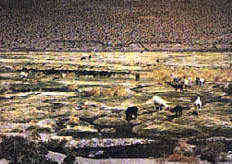
Every ritual celebration honors Achachillas or Mallkus (Lord or governor) and T'alla (Lady). They are appealed to them in times of crisis or need.
Specific and solemn Aymara cults take place in February: Godfather Days, when people climb to the hill and raise a pole called Arco which is dressed as a herdsman to represent the spirit.
Arco means new life after death; as well the seed, which falls in the soil, dies and produces new life.
This celebration takes place in houses, yards and corrals. The Aymara role is that of is celebrant, sacrificer or supplicant, however in religious festivities he is only a supplicant.
The wizard called Laika is the celebrant of rituals. The night is his domain, as well as caves, mines and inaccessible rock formations.
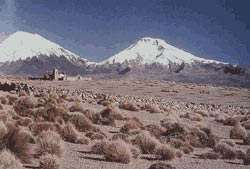
Customs
The oldest concept of Aymara tradition is directed to Achachillas or Mallkus, which are the snowy mountains spirits that surround the villages; along with Pachamama and Amaru Snake, linked to water, rivers and irrigation canals, which allow the subsistence of agricultural lands (3.000 - 2.000 Mts. height).
Religion
The Aymara belief system is a syncretic cyclical ritual, which coexists with and integrates two components: the prehispanic; an indigenous belief system from before the arrival of Spanish conquerors, and posthipanic religions, which introduced Catholic religion.
However, the Aymara vision of the cosmos is a whole, an annual cult following the rhythm of the seasons.
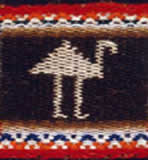
In the Aymaras textiles, the complexity and sophistication are amazing if you consider that it were of common knowledge. The knitted fabric are the feminine universe and the braided the masculine one. The technical details and symbolical richness that the fabrics and braides contain were a consecuence from the cattle-Andean thousand year experience and the use given to wool.
Textile elaboration technics are transmited from fathers to sons through generations.
The animal shaped figures and geometrical signs are used by Aymara women in their dresses.
Their are plenty of camelidos, vizcachas, suris and taguas, vegetable and geometrical motives, like the spiral or the double spiral that refers to their mysthical being and the world vision of their culture.
 Their textiles do not only play a useful function but also for monetary exchange.
Their textiles do not only play a useful function but also for monetary exchange.
In the coloring predominate their animal natural colours: brown, grey, white and black. To obtain a variety of colours, they used, since antiquity, plants and minerals to dye their wool. The dying technics are natural, allowing firmness in its colours. Nowdays these technics are almost obsolete, being replazed by industrial anilines from Bolivia.
The confection of textiles works with tedious and complex technics. The elaboration process begins obtaining the animal´s hair (Tarwa) by shearing animals (Alpacas, Llamas and sheep) that is maked with knifes or tinplate pieces. Finnally they select the fiber according to its type, quality and colours.
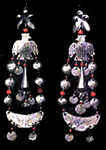
They used silver objets like personal ornaments. Standing out:
Tupus:
These were used to tie up the traditional dress (asku) in both sholders. The tupus have been replaced for simple pins and the small times that girls dress with the traditional custom, the "p'ichi" are esteemed ornaments. The tupus are formed by two spoons that end in a point, sharpenned like a big pin, joined by a chain. The hollow part of each spoon, has pictures carved that represent hearts, birds or vegetables. Bracelets (Pulsira) very limited, where used only in relevant social matters.
Earings or Sarcillu:
These earings were engraved with flowers or leaves. Sometimes pieces of glass or flagstone were added, that seem to be the fruits of the vegetable motives. The smaller earings were use daily and the bigger ones in special ocassions.
The Walcas, beed necklaces were an obligatory complement in the feminine ornament; made in glass or flagstone beeds of diverse colours, although in the past they were prefered in red beeds. Its length is variable. These were used wrapped around the neck.

Almost all these ways of Aymara music and dance no longer exist today.
According to different archaeological findings, one of the ancient musical instruments has been the phunkhullu. It had an evolution in their making materials from the clay, bony materials, until at the present vegetable canes, specially the Andean bamboo ones(suqusa, siqusa) of the zone of the Yungas and low valleys.
The bamboo cane, allows the invention of siku (siqus) and the sikuri (siqus phusiri).
Between the descendants of phunkhullu are the pinkillos, chacallos, quena-quenas, moseños, lawa k'umus and tarqas.
After the Spanish guitar influence was invented the charango (khirkhinchu), in some place of the north of the Potosí.
Musical Instruments

Pincullo o Pinquillo (Aerophone)
Vertical cane flute that measures 50 cetimeters, with an extreme superior mouthpiece. It gives a sharoer sound than the Quena.
Pusa o Sicura (Aerophone)
It is known by its european name Zampoña. It is formed by 12 hollow canes placed in two rows from minor to mayor, tied up in scale, when blowed give of certain musical notes. The opposite end of the canes is closed. A Zampoña cannot give a complete melody given the small number of notes it has. To accomplish it various musicians get together, were each one carries out a different Zampoña, building like that complete melodys, of beautifull sounds. It is a custom that the players get together with percussion accompaniment. It is common in Bolivia, Peru and the north of Chile. It is also called Laca, in Aymara it is Siku o Sikuri.
Charango (cordófono):
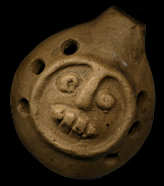
Charango (Cordophone)
A Guitar, indigenous replica of the spanish guitar, that its approximate total length is about seventy centimeters. It has a wooden neck, similar to the european instruments, the front part or the top has and 8 shape, like the guitar. The resonance box is of the shell of a quirquincho. It´s formed by ten strings, tuned in five double orders, mainly metallic.
Ocarina (Aerophone)
The use of the Ocarina has been lost in the Chilean North; but is kept in Putre, on the zone of Belen in Aiquina and in the Bolivian highlands.
Its length variates from 15 to 28 centimeters and its diameter goes from 5 to 10 cms. It is hard to make and to play, that´s why it´s been lost.
It seems that the pottery art had its origin on the idea conceived by a inhabitant, to cover his basket with clay, to warm it up, besides the fire. Little by little, in this industries evolution the esthetic and adornments have developed.
Orfebreria was the metal work. The silver was the main material used in the zone.
The objects could have had different functions. One of them was the ritual function in which the objects were used in the religious ceremonies. The other was the esthetic function, constituted mainly by jewels. Between the existing pieces, worked tediously, there are ring or surtijas that were used by both sexes ; pins or topus ; bracelets or pulsira that were used sometimes special, and hoops or sarcillu.
The jewelry had a symbol of status and were used by people to fancy themselves and look better.

Inside the Aymara and Quechua comunities, parties have kept their ritual meaning. Music and dancing do not only represent the solidarity of the Indigenous Cultures with its land, but also express the union of the community. Particularly you could see that in the Sikuris groups, complemented by instruments of different sizes. The interpretation requires a perfect coordination.
The native dances are a very important part in the ceremonies in which, even nowdays, the mother earth is worshiped. In all the Andean zone, although in diverse formes, you find various rituals; however, the meaning is the same: Fertility rituals and gratitude sacrifices (Ch´alla) to the Pachamama. These dances are: the Mollos, Inca Dance, Mokolulu, Monseñada, Chiriwana, Thanthas, Waka-waka, Kena-kena and Auki-auki.
Dance is an activity practiced by man, that was born by the necesity that this one had, of expressing through movement.
It is being spoken like spiritual motives characterizad by fear, petitions or gratitudes to the divinity; of erotic or afective reason; of the warrior reason to scare the enemy and self excite himself to attack in battle, or the reason leagued to the crop celebration, etc.
All this explains why dancing involves a message, it´s significant and has a spìritual content besides the esthetic.
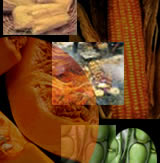 The Watia is an Andean dish. It is a kind of Andean curato that was tasted by the Quechua and Aymara people. It is prepared in a hole and covered with leaves of alfalfa, soil and stones.
The Watia is an Andean dish. It is a kind of Andean curato that was tasted by the Quechua and Aymara people. It is prepared in a hole and covered with leaves of alfalfa, soil and stones.
Receipe
The amounts of foods should be judged according to the number of guests.
Different types of meat (lamb, pork, alpaca, chicken), It could be optional.
Adjust seasonings to taste (pepper, cumin, locoto (chili), salt)
Sweet potatoes
Pumpkin
Choclo (maize)
Potatoes
Preparation:
Dig a hole in the ground and fill it with hot stones.
In a pan, cook the meat to your preference. Add seasonings to taste.
When the curanto is ready, put the pan over the stones and enclose it in sweet potatoes, maize and pumpkins wrapped in aluminium foil.
Cover with leaves of choclo or alfalfa, soil and damped bags.
Leave for an hour and serve with a cup of juice, chuño potatoes and watercress and lettuce salad.
Chuño potatoes: new potatoes that are stomped and left on the roof on frosty nights. After getting dark the potatoes can be cooked.
Related Sites:
http://titicaca.ucsb.edu/chamak_pacha/ethnographic/watia/
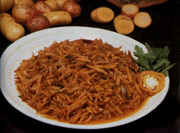 The Aymaras give thanks for rain
The Aymaras give thanks for rain
The CHAKANA (the Southern Cross)
"The Aymaras are everlasting men because they remember the past before move into future" Carlos Mile Villena "Genesis of the Andean Culture"
Cieza de León, chronicler, collected in his works:...."After flood, Pachacamac repopulate the earth sending four stars, two male and two female. From one of the two couple was born the kings and the nobles and from the other the ordinary people" (Varcalcel "History of ancient Perú": volume IV). The Aymara people was situated in the south of Peru. They knew Astronomy more than others. At the beginning of the month of May, they celebrate the cross feast as well as all Andean people. Despite of some beliefs, this celebration is related to the constellation that appears in the firmament: The southern cross.
It was a day of happiness, gratefulness. Because of the paradox of the Andean culture, they (the Aymaras and the Incas) ate a tuber which is similar to drops of rain. It can come in a wide range of colors (red, yellow, dwelled) and shapes (round and small plenty of juice and nutrients). It is named: OLLUKO.
Nowadays, in spite of its harvest is plentiful in May, Olluko is also produced in November when rains begins in this part of Andes region. It said that Olluko has fresh flavor that strengthen and gets the urge to generate the life again. Olluko had a close relation with the Andean worldview.
POTJE DE OLLUKO
Ingredients:
1/2 Kg chopped olluko
1/2 Kg chopped potatoes,
salt to taste,
2 cups "chicha de jora",
2 teaspoon dried ground chili,
1 tbsp sugar,
2 tbsp lard,
Chopped fresh cheese
Preparation:
Put dried ground chili, lard, salt, sugar and chicha de jora in a clay pot. Cook it for 10 minutes, then add Olluko and potatoes (parboil). Cook on a low heat for half hour. Se retira del fuego and spread fresh cheese.
To serve acompañado de perejil.
Colaboración enviada por Rodolfo Tafur Zevallos
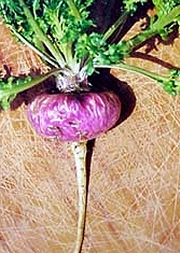 Maca is a legendary sex-enhancing root from Perú, that was first used by the Incas and discovered by the Chibcha Herbalists. Maca is a root that looks like a little turnip or radish that contains high amounts of vitamins (B1, B2, B12, C, E, caroteno), mineral, and the essential amino acids.
Maca is a legendary sex-enhancing root from Perú, that was first used by the Incas and discovered by the Chibcha Herbalists. Maca is a root that looks like a little turnip or radish that contains high amounts of vitamins (B1, B2, B12, C, E, caroteno), mineral, and the essential amino acids.
Maca grow at altitudes beetwen 3.500 and 4.500 meters above sea level, on the plateau of Bombom in the departments of Junón and Pasco in Peru. A member of the Cruciferous family, there are four varieties of "maca". In the natural habitat where maca is grown, temperatures during the day reach 7°C and at night can drop as low as -8°C.
When the Spaniards arrived in Peru, according to their chronicles, maca was also demanded as tribute by the conquering Spaniards. Maca was used as an energy enhancer and for therapy, increasing male potency, or improving other hormonal function.
The Maca flour has aphrodisiac and fertility-enhancing properties. Two spoons of maca flour per day, mixed with milk, juices, beverages is usually recommended.
RECIPE
MACA COCKTAIL
INGREDIENTS:
Dried maca root: 1 kg
Sugar: ½ kg
Aguardiente de Caña (Caña)*: ½ bottle
Anise flavored liquor: to taste
Milk: 1 litre
* Liquor made from sugar cane.
PREPARATION:
In a saucepan, boil the dried maca root in salted water. Liquefy it with the milk. Add sugar until to thiken, then add the Caña and Anise flavored liquor
MACA JAM
INGREDIENTS:
Dried maca roots: 1 kg
Bee honey or Sugar: to taste
Cinnamon and Clove: to taste
PREPARATION:
Wash the dried maca roots. Soak for at least one day, then boil in salted water. Cut it into small pieces and liquefy with sugar or bee honey.
:
Related sites:
http://www.aldearural.com/fororural/index.htm
http://www.mercadolibre.cl
www.agrilogica.com